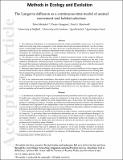Files in this item
The Langevin diffusion as a continuous-time model of animal movement and habitat selection
Item metadata
| dc.contributor.author | Michelot, Théo | |
| dc.contributor.author | Gloaguen, Pierre | |
| dc.contributor.author | Blackwell, Paul G. | |
| dc.contributor.author | Etienne, Marie-Pierre | |
| dc.date.accessioned | 2020-08-23T23:34:25Z | |
| dc.date.available | 2020-08-23T23:34:25Z | |
| dc.date.issued | 2019-08-24 | |
| dc.identifier | 260405966 | |
| dc.identifier | 5c0c35ad-1d30-42c8-9bd3-531eb5eee7a0 | |
| dc.identifier | 85070964750 | |
| dc.identifier | 000488345900001 | |
| dc.identifier.citation | Michelot , T , Gloaguen , P , Blackwell , P G & Etienne , M-P 2019 , ' The Langevin diffusion as a continuous-time model of animal movement and habitat selection ' , Methods in Ecology and Evolution , vol. Early View . https://doi.org/10.1111/2041-210X.13275 | en |
| dc.identifier.issn | 2041-210X | |
| dc.identifier.other | RIS: urn:127655CBDF9AF73CDF5C7F9A5FB7A810 | |
| dc.identifier.uri | https://hdl.handle.net/10023/20501 | |
| dc.description | TM was supported by the Centre for Advanced Biological Modelling at the University of Sheffield, funded by the Leverhulme Trust, award number DS-2014-081. | en |
| dc.description.abstract | 1. The utilisation distribution of an animal describes the relative probability of space use. It is natural to think of it as the long-term consequence of the animal's short-term movement decisions: it is the accumulation of small displacements which, over time, gives rise to global patterns of space use. However, many estimation methods for the utilisation distribution either assume the independence of observed locations and ignore the underlying movement (e.g. kernel density estimation), or are based on simple Brownian motion movement rules (e.g. Brownian bridges). 2. We introduce a new continuous-time model of animal movement, based on the Langevin diffusion. This stochastic process has an explicit stationary distribution, conceptually analogous to the idea of the utilisation distribution, and thus provides an intuitive framework to integrate movement and space use. We model the stationary (utilisation) distribution with a resource selection function to link the movement to spatial covariates, and allow inference about habitat preferences of animals. 3. Standard approximation techniques can be used to derive the pseudo-likelihood of the Langevin diffusion movement model, and to estimate habitat preference and movement parameters from tracking data. We investigate the performance of the method on simulated data, and discuss its sensitivity to the time scale of the sampling. We present an example of its application to tracking data of Steller sea lions (Eumetopias jubatus). 4. Due to its continuous-time formulation, this method can be applied to irregular telemetry data. The movement model is specified using a habitat-dependent utilisation distribution, and it provides a rigorous framework to estimate long-term habitat selection from correlated movement data. The Langevin movement model can be approximated by linear model, which allows for very fast inference. Standard tools such as residuals can be used for model checking. | |
| dc.format.extent | 2026679 | |
| dc.language.iso | eng | |
| dc.relation.ispartof | Methods in Ecology and Evolution | en |
| dc.subject | Animal movement | en |
| dc.subject | Continuous time | en |
| dc.subject | Resource selection | en |
| dc.subject | Step selection | en |
| dc.subject | Langevin diffusion | en |
| dc.subject | Potential function | en |
| dc.subject | Utilisation distribution | en |
| dc.subject | QH301 Biology | en |
| dc.subject | QA Mathematics | en |
| dc.subject | DAS | en |
| dc.subject.lcc | QH301 | en |
| dc.subject.lcc | QA | en |
| dc.title | The Langevin diffusion as a continuous-time model of animal movement and habitat selection | en |
| dc.type | Journal article | en |
| dc.contributor.institution | University of St Andrews. Statistics | en |
| dc.identifier.doi | 10.1111/2041-210X.13275 | |
| dc.description.status | Peer reviewed | en |
| dc.date.embargoedUntil | 2020-08-24 |
This item appears in the following Collection(s)
Items in the St Andrews Research Repository are protected by copyright, with all rights reserved, unless otherwise indicated.

